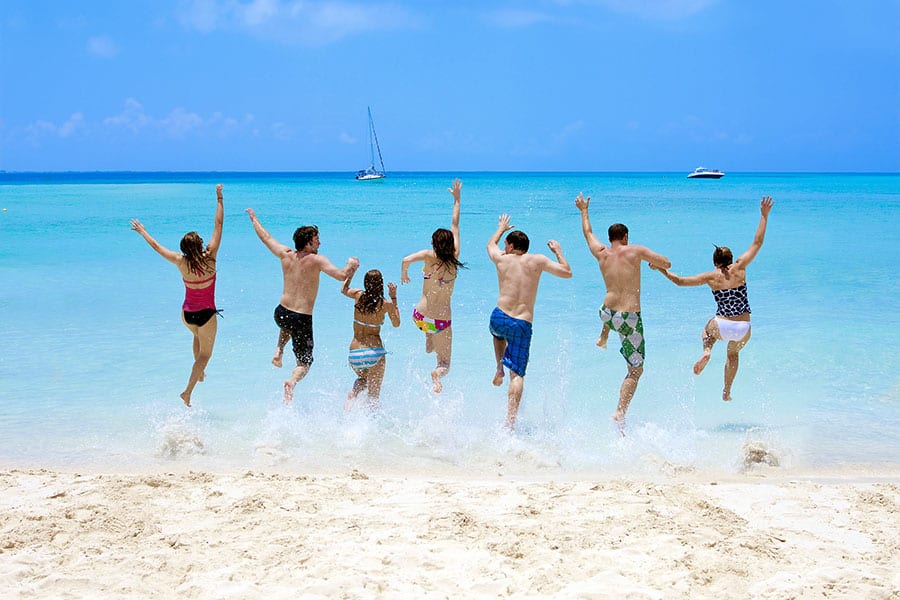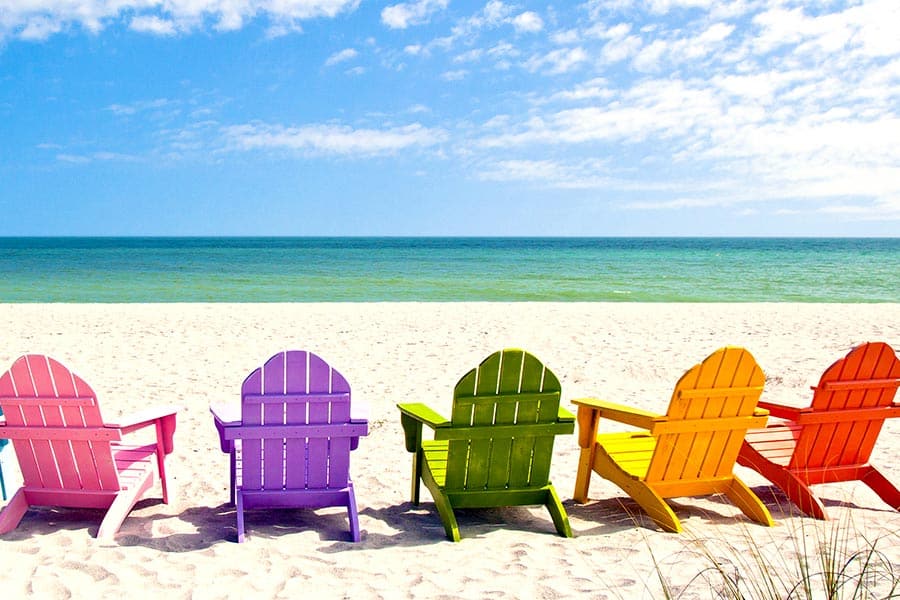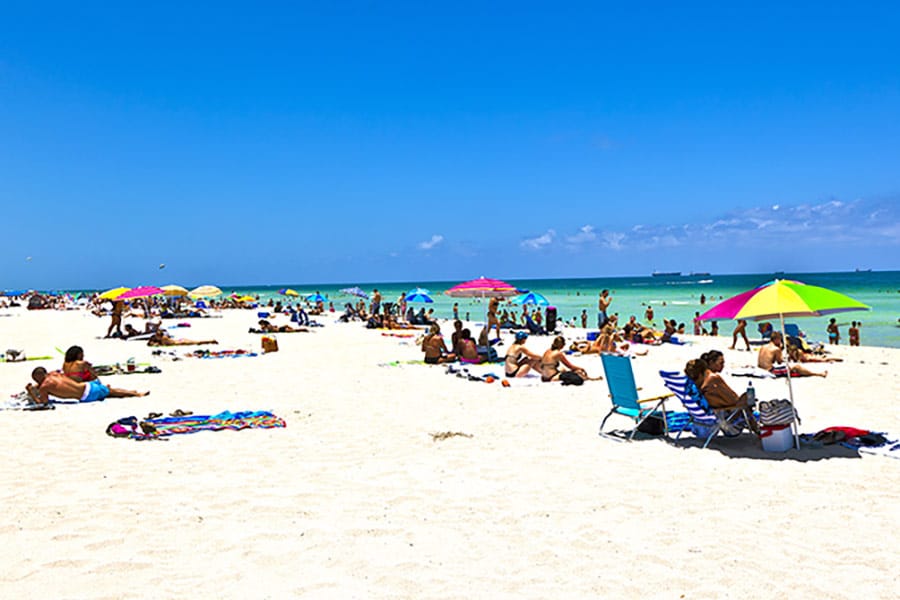
In many places swimming in the ocean is an invitation to hypothermia. Not so in the warm waters of the Sunshine State! But which side of Florida has warmer water?
Florida’s east coast, on average, has warmer water than the west coast. However, in the summer months, the Gulf of Mexico has warmer water than the Atlantic. Water temperatures in Florida tend to get warmer the further south you go – for example, Key West will have warmer water than Jacksonville.
So, where is the warmest water in Florida? Can you swim year-round in all parts of the state, or only in south Florida? Is the water still warm in the panhandle? Find the answers to these questions and the best time of year to plan your beach trip in the following sections.
Let’s Go Swimming – Which Florida Coast Has Warmer Water
Taking a dip in the ocean in Florida is refreshing. The waters are generally quite warm, and in the peak summer months, going swimming in the ocean in Florida is almost like taking a salty bath. It’s quite a difference from the ocean waters in places like Maine, Oregon, or even the Carolinas.
That said, water temperatures vary day by day and season by season. Changes in water temperature depend on factors like solar absorption, air turbulence, the temperature gradient between the water’s surface and the surrounding area, and the surface area of the body of water.

The surface area is important to understand. The Gulf of Mexico tends to have wider temperature swings because it has a smaller surface area than the Atlantic Ocean. The Gulf has a surface area of about 617,800 square miles, compared to the Atlantic’s whopping 41.1 million square miles – the Atlantic is 66 times bigger than the Gulf.
It takes a lot more energy to heat or cool the Atlantic than it does the Gulf.
Phenomenal Florida Fun Fact: Iguanas, commonly found in South Florida, are excellent swimmers – it’s not uncommon to see one in the waters around South Florida. Be careful in winter, though, as they sometimes fall out of trees when they get cold.
So what does that mean for finding warm water in Florida? Well, in the summer, the Gulf has warmer waters because it heats up quicker – but it also has cooler waters in the winter because it cools down just as quickly.
So where should you go to find warm swimming water in Florida? To answer that question, we’ve selected a few key cities to analyze water temps on the east and west coast. Then, we’ll go season-by-season to show you what the water temps look like in coastal cities of similar latitude across the Sunshine State throughout the year.

Our east-coast lineup includes:
- Jacksonville
- Daytona Beach
- West Palm Beach
- Miami
And our west-coast lineup is:
- Panama City
- Cedar Key
- Fort Myers
- Marco Island
All temperatures are reported as average and in Fahrenheit. As a point of reference, the average hot shower is about 105 degrees, and the average person finds water to be “cold” at about 70 degrees. So, without further ado, let’s launch into spring.
Spring – Average Water Temperature:
| City | March | April | May |
|---|---|---|---|
| Jacksonville (East) | 60.7 | 67.8 | 74.1 |
| Panama City (West) | 64.9 | 69.8 | 76.3 |
| Daytona Beach (East) | 67.3 | 71.4 | 75.9 |
| Cedar Key (West) | 66 | 72.9 | 78.8 |
| West Palm Beach (East) | 77.2 | 79 | 81 |
| Fort Myers (West) | 70.7 | 75.9 | 80.4 |
| Miami (East) | 76.8 | 78.6 | 81 |
| Marco Island (West) | 72 | 77 | 81.1 |
The spring months bring cooler water to the beaches of both northeast and northwest Florida. While swimming in March and April is a bit dodgy in most of north and central Florida, both the east and west coast have favorable water temperatures for springtime swimming. So we crunched the numbers, and here’s what we came up with.
East Coast spring average: 74.2
West Coast spring average: 73.8
Winner: East Coast. Florida’s east coast enjoys warmer waters in the spring than Florida’s west coast! That said, you may not want to swim in March or April unless you’re somewhere in south Florida. If you do decide to take a dip in the chilly waters of Jacksonville or Cedar Key in March, be aware that water temps of 60 degrees can lead to hypothermia in an hour or so.

Summer – Average Water Temperature:
| City | June | July | August |
|---|---|---|---|
| Jacksonville (East) | 79.4 | 81.9 | 83.1 |
| Panama City (West) | 82.6 | 84.6 | 85.3 |
| Daytona Beach (East) | 80.1 | 81.9 | 82.4 |
| Cedar Key (West) | 84.2 | 86 | 86.2 |
| West Palm Beach (East) | 83.3 | 84.7 | 85.6 |
| Fort Myers (West) | 84.6 | 86.2 | 86.7 |
| Miami (East) | 83.7 | 85.3 | 86 |
| Marco Island (West) | 85.1 | 86.4 | 86.9 |
East Coast summer average: 83.1
West Coast summer average: 85.4
Winner: West Coast. Summer brings balmier weather and plenty of sunshine and heat. While the frigid Atlantic is a little slow to warm, the Gulf gets nice and toasty in the summertime. There’s nothing quite like dipping your toes into the pleasantly warm waters of the Gulf on a hot summer day!
Other Posts of Interest
- What Is The Most Visited Beach In Florida?
- Is It Illegal To Take Dead Sand Dollars From The Beach In Florida?
- What Is The Most Visited City In Florida? And Why
- Is It Illegal To Take Shells From Florida Beaches?
Autumn – Average Water Temperature:
| City | Sept. | Oct. | Nov. |
|---|---|---|---|
| Jacksonville (East) | 82.4 | 78.3 | 70.9 |
| Panama City (West) | 83.7 | 78.6 | 71.1 |
| Daytona Beach (East) | 82.6 | 79.7 | 73.4 |
| Cedar Key (West) | 83.8 | 78.3 | 69.4 |
| West Palm Beach (East) | 84.9 | 83.5 | 80.8 |
| Fort Myers (West) | 85.5 | 81.5 | 74.8 |
| Miami (East) | 85.1 | 83.3 | 80.4 |
| Marco Island (West) | 85.6 | 82 | 75.4 |
East Coast autumn average: 80.4
West Coast autumn average: 79.1
Winner: East Coast. Autumn in Florida doesn’t really exist in the same way that it does in other states. It’s mostly a long extension of summer that abruptly begins to cool off in late November or early December. The gradual cooling does bring slightly cooler water temps, but going to the beach to swim or snorkel in autumn is definitely a viable activity.
Winter – Average Water Temperature:
| City | Dec. | Jan. | Feb. |
|---|---|---|---|
| Jacksonville (East) | 63.4 | 59.3 | 58.9 |
| Panama City (West) | 60.4 | 62.2 | 62.1 |
| Daytona Beach (East) | 69.3 | 66.9 | 66.6 |
| Cedar Key (West) | 64.6 | 61 | 61.7 |
| West Palm Beach (East) | 79 | 77.2 | 76.8 |
| Fort Myers (West) | 70.7 | 67.8 | 68 |
| Miami (East) | 78.3 | 76.5 | 76.3 |
| Marco Island (West) | 71.8 | 69.1 | 69.4 |
East Coast winter average: 70.7
West Coast winter average: 65.7
Winner: East Coast. The winter “chill” here begins to set in around December and usually lingers on through February, sometimes early March. So while winter is pretty mild, the water starts to feel colder in many parts of Florida. So while you’ll definitely find warmer waters here than in, say, Rhode Island, you’ll want to make sure you don’t get too cold if you go swimming in the Florida winter.
Is the Water Warm Enough in Florida to Swim Year Round?
Most people find water temperatures below 70 degrees to be cold. In northern Florida, water temps can be in the 60s in the winter and spring months. While you certainly can go swimming in 65-degree water, it is going to feel cold, and you must be careful not to get hypothermia.

If you want to find a place where you can swim year-round, far southern Florida is your best bet. The water temps in Miami and Marco Island tend to stay warm, although they can occasionally dip down below 70.
What Beach in Florida has the Warmest Water?
If you want to experience the warmest water in Florida, you should head to Key West. Key West, home of the Southernmost Point in the United States, enjoys warm water temps year-round. The most popular beach in Key West is Smathers Beach, which offers two miles of sandy beaches, mild waves, and warm water.
For a different type of beach experience, head to Fort Zachary Taylor Beach. This beach, part of a state park, has a more natural shoreline comprised of ground coral. It’s also great for snorkeling and features authentic local plants and trees near the shoreline.
Is the Water Warmer in the Florida Keys or the Peninsula?
The water in Florida is much warmer in the Keys than in the peninsula. Even in the winter months, the water in Key West rarely drops below the mid-70s. In many places in the Florida peninsula, water temperatures can fall into the 60s, which makes for a relatively cold swim.
Splashing Away
Swimming is an excellent activity for anyone in Florida. Whether you’re a pro swimmer who loves to do the breaststroke in the water or an amateur hanging on to a floatie or a pool noodle, you can enjoy taking a swim in the ocean here. You can swim year-round, but be aware that water temps do get cool in the winter, especially in north Florida.
In terms of which coast has warmer waters, the waters of Florida’s east coast are, on average, warmer than the waters of the Gulf coast. However, in the summer months, the Gulf’s waters tend to get warmer than those of the Atlantic. So, whichever coast you head to, you’ll find swimming in Florida to be a super fun activity. So bring your snorkel and your goggles, plant an umbrella in the sand, and dive on in!





